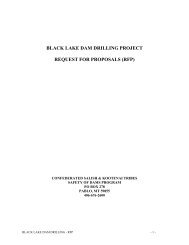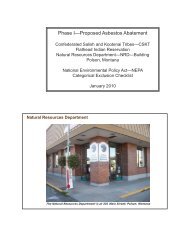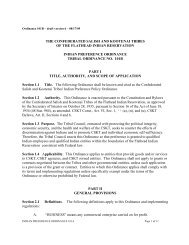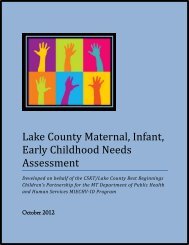US EPA - The National Pesticide Tribal Program - US Environmental ...
US EPA - The National Pesticide Tribal Program - US Environmental ...
US EPA - The National Pesticide Tribal Program - US Environmental ...
Create successful ePaper yourself
Turn your PDF publications into a flip-book with our unique Google optimized e-Paper software.
Case Study: Compliance Assistance and Outreach<br />
<strong>Program</strong>s Reduce Violations<br />
Protection through education and timely information<br />
exchange are important tools to help growers minimize<br />
pesticide risks. <strong>The</strong> Colorado River Indian Tribes (CRIT)<br />
pesticide program conducts a comprehensive compliance<br />
assistance and outreach program for all the agri-business<br />
in the community.<br />
One tool CRIT provides to growers is a check list<br />
identifying the components necessary to be compliant<br />
with tribal and federal codes and regulations and to<br />
perform a self-evaluation of its current operations. At a<br />
pre-determined date, pesticide inspectors review the selfassessment<br />
check list with the participant, point out areas<br />
of concern, and answer any questions by the participant.<br />
Both parties then agree on the amount of time necessary<br />
to address targeted areas for improvement.<br />
With cooperation from farmers, pesticide dealers,<br />
applicators, inspectors, pesticide control advisors (PCAs),<br />
and local agri-businesses, CRIT has developed a <strong>Pesticide</strong><br />
Tracking System to provide inspectors with the necessary<br />
information needed to proactively deal with pesticide<br />
issues. <strong>The</strong> system allows CRIT to identify and track<br />
pesticide aerial, chemigation, and ground applications in<br />
every single agricultural field of the 85,000 acres that are<br />
currently under production.<br />
CRIT is also able to track tribal and state pesticide<br />
certifications and permit expiration dates of dealers, PCAs,<br />
growers, pesticide handlers, and applicators. Information<br />
in the tracking system is also portable by way of laptop<br />
computers in vehicles that inspectors carry in the field.<br />
This allows pesticide staff to observe an application in<br />
progress and identify the field and the grower in real time.<br />
<strong>The</strong>y can then look at the <strong>Pesticide</strong> Tracking System, and<br />
verify if a form 1080, Notice of Intent, has been submitted<br />
for that application.<br />
Case Study: Tribe Uses Grant to Establish School<br />
IPM <strong>Program</strong> to Control Pests and Reduce<br />
<strong>Pesticide</strong> Use<br />
In 2002, <strong>EPA</strong> provided a grant to support the development<br />
of an integrated pest management (IPM) pilot project in<br />
the Salt River Pima-Maricopa Indian Community schools.<br />
<strong>The</strong> funds provided in that grant were used by the tribe to<br />
perform an IPM assessment to identify the extent of the<br />
pest issues in their community schools and to identify<br />
strategies for ecologically sound pest management<br />
approaches, such as:<br />
• Improved hygiene standards.<br />
• Exclusion methods.<br />
• Habitat manipulation.<br />
• Biological control species, such as ladybugs,<br />
mantids, geckos, and housecats.<br />
• Selection of target specific control products that<br />
have low toxicity and environmental impact, such<br />
as insect growth regulators<br />
• Non-chemical pest control products, such as glue<br />
boards and ultraviolet lights.<br />
<strong>The</strong> goals of this pilot were a 90% reduction in chemical<br />
pesticide usage in the piloted schools, an 85% reduction<br />
in pests, a better understanding of IPM, the ability to<br />
further implement an IPM program in tribal schools, and<br />
the knowledge to implement IPM methods in tribal homes<br />
within the Salt River Pima-Maricopa Indian Community.<br />
<strong>Pesticide</strong> compliance assistance information<br />
is available for tribes at www.epa.gov/<br />
tribalcompliance/currentaffairs.html.<br />
Worker Protection<br />
Safety Training<br />
conducted at<br />
Colorado River<br />
Indian Tribes (CRIT)<br />
farm.<br />
<strong>EPA</strong> Region 8<br />
staff conducting<br />
IPM training for<br />
tribal inspectors<br />
at local school.<br />
Proper food<br />
storage in<br />
school’s kitchen<br />
is discussed.<br />
www.epa.gov/pesticides/tribes
















